
 |
 |
 |
What Does the Belt Colour Signify?
| |
The belt ranking or colour system was first introduced by Jigoro Kano, the founder of modern judo, as a way to keep track of progress for both the student and instructor. Ranks and colours also serve to some extent to motivate or reward a student. The actual colours and ranks can vary for each martial art as well as by style and organization, but the common factor is the white (shiro obi) and the black belt. One story as to why the black belt is considered an advanced rank is that as a beginner, one would start out with a white belt and over time through hard training, the belt would gradually start to become darker and darker until it would seem black. You may have also noticed that a black belt constantly worn over and over during training starts to fade, revealing the underlying white. One should never forget that we are all truly white belts. This is the concept of the beginner's mind...we all return to our beginnings and we should never forget where we came from.
|
White - Purity
| |
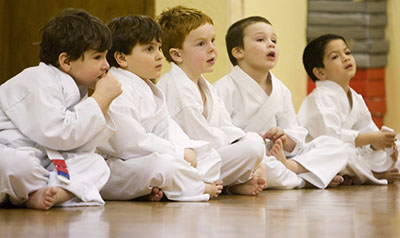
White is the symbol of purity, at least in English and Japanese based cultures. The new white belt student might be described as pure, being completely ignorant of the requirements of the art. The purity is lost as soon as the first exercise is performed in the dojo. The pristine colour is gone forever through sweat and dust, and the journey through the colour spectrum begins. There is no shame in being a white belt and the instructor more than the others is aware of this because he or she was once one too. In the Honbu dojo in Japan, while under Mas Oyama, the tradition was that uchi-deshi white belts (live-in or full-time students) would shave their heads as a sign of their dedication. The third year uchi-deshi - newly graduated black belts - also did this to indicate humility, symbolizing the return to the spirit of a beginner.
|
Orange - Stability
| |
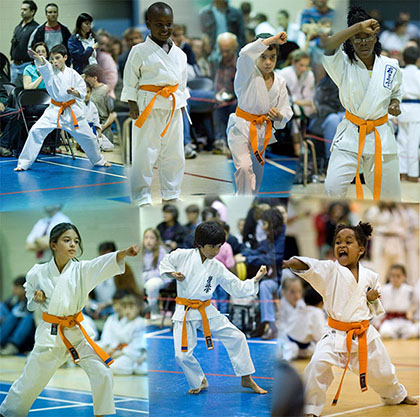
In many countries or dojos, a red belt is used to indicate this level (10th Kyu / 9th Kyu). For a while in Japan, the white belt first gained one black stripe then a second one. Currently the system used throughout the I.K.O. is an orange belt. The reason for the change is that in some karate systems, the red belt actually denotes a very high rank (eg. 5th Dan or higher) and to have junior kohai wearing such a belt would belittle those red-belted yudansha. In the run up to and throughout the orange belt training, you develop the very basics of karate. You unlearn any ideas you had about how to fight and you learn about your body. Anyone who has been through this stage will tell you that this is where they learned their body had muscles where they didn't even know they existed! It is here too that you begin to develop a sense of balance and coordination between the various body parts, with an emphasis on stance. You should also be familiar with dojo etiquette at this stage.
|
Blue - Fluidity and Adaptability
| |
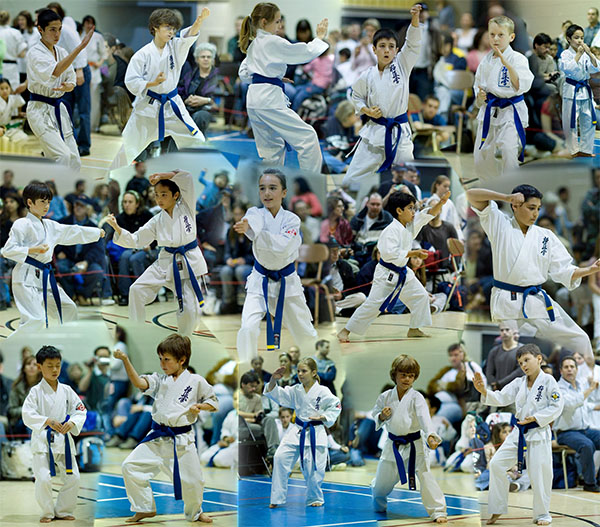
While the orange belt aspects of training must be continued, the karate-ka now begins to work on the upper body, strength, flexibility and coordination. It is here that you learn to overcome the urge to "take it easy" and if successful, training becomes a pleasure. The student begins to feel the benefits of training with an increased sense of well being, a bigger bounce in one's step and overall better fitness. Here the karate-ka must start taking control of mind and body. This might take the form of not showing pain when hit during sparring, not showing exhaustion during training, not wiping the drop of sweat off one's nose because one has not been told to do so yet, not yawning despite extreme fatigue, etc.
|
Yellow - Assertion
| |
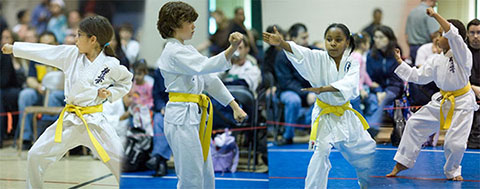
Here you learn to focus your power by concentrating it on the hara (the general area of the lower abdomen) or the tanden (the single point in the lower abdomen that more or less corresponds to the center of gravity of the body). Fortunately for most of us, this point is just behind where we tie the knot of our belts. This is the first level where training begins to concentrate on the psychological aspects, with an emphasis on mind-body coordination. It is here that the karate-ka must begin to develop both power and speed when performing techniques. The yellow belt is the last of the "raw beginner's" belts and the karate-ka begins to take control of his or her life, body and environment.
|
Green - Emotion and Sensitivity
| |
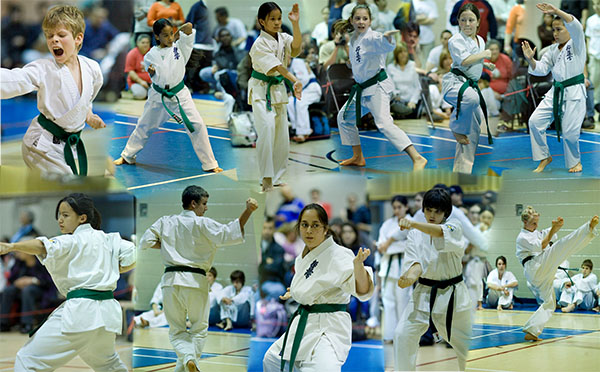
Green belt (midori obi) marks the first of the advanced levels. It is similar to starting again from the beginning as everything changes and the seriousness of karate becomes evident. The comfort level changes as well because a green belt starts to train with advanced belts far superior in knowledge and experience.
|
Brown - Practical and Creative
| |
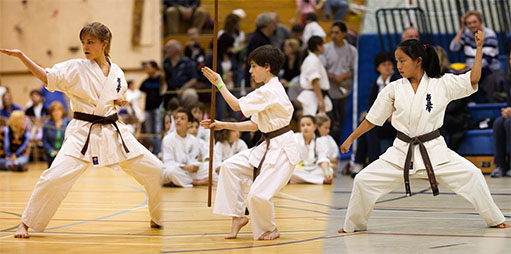
Brown belt is the point at which students begin to create their own techniques and combinations. They start to "find" themselves and come into their own. Through imitation and the copying of techniques and mannerisms from higher belts, the experience and personality of the karate-ka begins to emerge.
|
Black - Achievement
| |
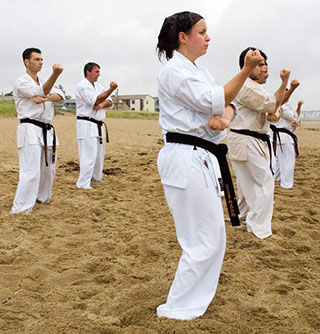 THE BLACK BELT! This is the most coveted belt. "I am a black belt!" "Watch out! He's/She's a black belt!" Even non-karate-ka know the term black belt. Everyone wants one, but few understand what it really is to be one. Sadly, even many black belts themselves do not grasp what it represents. Too many think that it is an accomplishment in itself and quit training shortly afterwards. We could have a very lengthy discussion regarding what a black belt really is, but here, we will attempt to briefly explain how it is viewed by West Island Karate. THE BLACK BELT! This is the most coveted belt. "I am a black belt!" "Watch out! He's/She's a black belt!" Even non-karate-ka know the term black belt. Everyone wants one, but few understand what it really is to be one. Sadly, even many black belts themselves do not grasp what it represents. Too many think that it is an accomplishment in itself and quit training shortly afterwards. We could have a very lengthy discussion regarding what a black belt really is, but here, we will attempt to briefly explain how it is viewed by West Island Karate.
Black belt is a new beginning, a re-birth, becoming a beginner again. By no means is it a destination. Rather, it is a new stage in a long journey. It is a state of being. It dictates how we conduct ourselves and it is a culmination of personal growth that one has achieved through many hours of training and introspection.
|
|
|
 |
|
|
 |
|
|
|
 © Copyright 1996. All rights reserved by West Island Karate ®.
© Copyright 1996. All rights reserved by West Island Karate ®.
 |
|
|







































 THE BLACK BELT! This is the most coveted belt. "I am a black belt!" "Watch out! He's/She's a black belt!" Even non-karate-ka know the term black belt. Everyone wants one, but few understand what it really is to be one. Sadly, even many black belts themselves do not grasp what it represents. Too many think that it is an accomplishment in itself and quit training shortly afterwards. We could have a very lengthy discussion regarding what a black belt really is, but here, we will attempt to briefly explain how it is viewed by West Island Karate.
THE BLACK BELT! This is the most coveted belt. "I am a black belt!" "Watch out! He's/She's a black belt!" Even non-karate-ka know the term black belt. Everyone wants one, but few understand what it really is to be one. Sadly, even many black belts themselves do not grasp what it represents. Too many think that it is an accomplishment in itself and quit training shortly afterwards. We could have a very lengthy discussion regarding what a black belt really is, but here, we will attempt to briefly explain how it is viewed by West Island Karate.